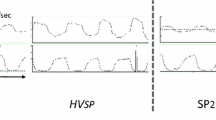Abstract
Hyperventilation was first described in the middle of the 19th century, with soldiers in the American Civil war complaining of symptoms originally thought to be cardiac in nature1. However, these symptoms were later discovered to be identical to idiopathic hyperventilation. Since this time there has been limited published data and little consensus as to existence and cause of this condition. The symptomatology is varied; however the principle symptoms include shortness of breath, chest tightness and parasthesia. The physiological variables associated with idiopathic hyperventilation are disproportionate breathlessness and evidence of hyperventilation at rest and during exercise. A disorganised breathing pattern has also been described, with no relationship between the ventilatory response and the level of exercise. This altered physiological response has been suggested to be due to a neuromuscular disturbance. Patients with idiopathic hyperventilation (IH) have also been described to have an altered psychological profile. Soley and Shock2 in 1938 reported a relationship between symptomatology consistent with IH and psychological factors. Lowry in 1967 suggested that IH was identical to hysteria, patients consider themselves physically inferior and have perfectionist traits3. Lum4 described the most comprehensive explanation of the physiological and behavioural aspects of this condition. He hypothesised that IH may be initiated by anxiety. This emotional state creates symptoms, which are perceived and interpreted by the patient. A vicious circle then ensues whereby patients interpret the symptoms as life threatening, this creates further anxiety with increased hyperventilation and symptomatology. Plum5 proposed a model of interaction of the motor behavioural pathway and metabolic pathway. The motor behavioural pathway functions in addition to the metabolic pathway
Access this chapter
Tax calculation will be finalised at checkout
Purchases are for personal use only
Preview
Unable to display preview. Download preview PDF.
Similar content being viewed by others
Reference
DaCosta J.M. On irritable heart: a clinical study of a form of functional cardiac disorder and it consequences. Am. J Med Sci 1871; 61: 17–52.
Soley M, Shock N. The aetiology of effort syndrome. Am J Med Sci 1938; 196: 840–51.
Lowry T. P. Hyperventilation and hysteria. 1967; Springfield, III, Charles C. Thomas
Lum C. The syndrome of habitual chronic hyperventilation. In: Modem trends in psychosomatic medicine. O. W. Hill ed. Bitterwoth publ, London. 1976; 11: 196–230.
Plum F. Neurological integration of behavioural and metabolic control of breathing In: Porter R, ed. Breathing: Hering — Breuer Centenary Symposium. London: Churchill 1970;159–81.
Howell J.B.L. The hyperventilation syndrome: a syndrome under threat? Thorax 1997; 52(3) s: 30–34.
Owen M.J, Jack S, Oates K.E, Pearson M.G and Warburton C. The effect of psychological factors on physiological variables in patients with idiopathic hyperventilation. European Respir J 1998; 12(28): 412S.
Morgan N. and Cameron I. R. Respiratory response to behavioural and metabolic stimulation. Clin Sci 1984; 67 (Suppl 9): 61 p.
Masoaka Y and Homma I Anxiety and respiratory patterns: their relationship during mental stress and physical load. Int J Psychophysiol. 1998; 27: 153–159.
Dudley D. L and Pitts-Poarch A.R Psychological aspects of respiratory control. Clinics in Chest Medicine 1980; 1(1): 131–143.
Mador M. J., and Tobin M.J. Effects of alteration in mental activity on the breathing in healthy subjects. Am Rev Respir Dis 1991; 144: 481–487.
Bechbache R.R, Chow H.H.K, Duffin J and Orsini E.C. 1979 The effects of hypercapnia, hypoxia, exercise and anxiety on the pattern of breathing in man. J Physiol 1979; 293: 285–300.
Dixhoorn Van J. and Duivendoorn H.J. Efficacy of Nijmegen questionnaire in recognition of the hyperventilation syndrome. J. Psychosom 1984; 29: 199–206.
Jack S. Pearson M.G. and Warburton C.J. A clinical index to assess breathing pattern in early exercise: The Aintree Breathing Pattern Index (ABPI) Am Rev Resp Crit Care Med 2000.
Jack S. Wilkinson M. and Warburton C.J. Behavioural breathing pattern during hypocapnic and normocapnic exercise in idiopathic hyperventilators. Am Rev Resp Crit Care Med 2000; 161(3): A431
Author information
Authors and Affiliations
Editor information
Editors and Affiliations
Rights and permissions
Copyright information
© 2001 Springer Science+Business Media New York
About this chapter
Cite this chapter
Jack, S., Warburton, C.J. (2001). A Physiological and Psychological Model of Idiopathic Hyperventilation. In: Poon, CS., Kazemi, H. (eds) Frontiers in Modeling and Control of Breathing. Advances in Experimental Medicine and Biology, vol 499. Springer, Boston, MA. https://doi.org/10.1007/978-1-4615-1375-9_71
Download citation
DOI: https://doi.org/10.1007/978-1-4615-1375-9_71
Publisher Name: Springer, Boston, MA
Print ISBN: 978-1-4613-5522-9
Online ISBN: 978-1-4615-1375-9
eBook Packages: Springer Book Archive




